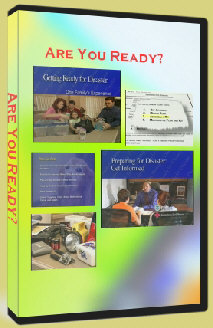Your Emergency Preparedness Kit
In this uncertain world, it is important to have an emergency preparedness kit for you and your family. This article will explain the items that should be included in a basic emergency supply kit. The logic behind its design is to give you a several day safety margin to allow for relief workers to move in and start helping in the case of a true emergency - like a hurricane, tornado or flood. But the kit can help you overcome much more mundane disasters like losing power for a few days - or being stranded on a little traveled road.
You should plan on building a kit that can give you food and water for three to five days. It should also contain a variety of essential nonfood supplies to handle contingencies. As a minimum, your kit should include:
- One gallon of water per person per day. So if you had a family of four, it should contain 12 gallons of water for three days. This water will be used for drinking and for sanitation.
- Food for as many days as you build your kit. Canned foods are good as they can be eaten without cooking and have a very long shelf life.
- A radio that is either battery powered or self powered with a hand crank. The radio should be able to receive NOAA Weather alerts. If the radio is battery operated, be sure to have enough batteries for it.
- A flashlight - either one with batteries or a hand crank flashlight. If your flashlight requires batteries, be sure to have the correct number and type of batteries for it. Keep in mind that LED flashlights last much longer than regular flashlights on a single set of batteries.
- A good first aid kit. This is a good place to invest a bit of extra money in a high quality first aid kit. It will have many more of the supplies that might be needed in an emergency than your basic first aid kit. Also keep in mind that there are perishable items in first aid kits so you should periodically go through it and replace the expired items.
- A whistle or other device to make noise so you can signal for help. A whistle is best as it works all the time but there are compressed air products that make a very loud noise that are also good. But keep in mind that they stop working when the air runs out of the can so having a whistle as a backup in this case is good.
- A dust mask for each family member, plastic sheeting and duct tape. This will allow you to build a temporary dust free shelter should the need arise.
- Personal sanitation items like moist towelettes, toilet paper and garbage bags with ties to store the waste materials.
- A can opener to open your canned food.
- A good pocket knife or other utility knife.
- A set of local maps.
Many of the items in the above list have expiration dates - especially bottled water and canned food. It is a good idea to rotate supplies in your emergency preparedness kit to ensure freshness.
Depending on your situation, there are many other items to consider for your emergency preparedness kit. They include:
- Prescription medicines
- A spare pair of glasses
- Infant formula and diapers
- Pet food and extra water for your pet
- Important family documents - insurance policies, bank accounts, etc. They should be stored in a waterproof container.
- Cash or travelers checks
- A first aid book for reference
- Extra climate appropriate clothing
- Fire extinguisher
- Waterproofed matches
- Personal hygiene items
- Eating utensils
By planning ahead, you can build most of your emergency preparedness kit based on items you already have in your house. And the items you do not have can be purchased a little at a time until you have a full kit. You should keep your kit in an easy to reach place so that if you need to leave your home quickly, it can be loaded into your car without any delay. One or two large sealable plastic containers are ideal for storing your emergency items. Just be sure that they are not packed too heavy to lift. Your goal should be to be able to pack all your emergency supplies in your car and be on your way in just a few minutes.
While having an emergency preparedness kit will not guarantee your safety during an emergency, it will give you much more flexibility and more options than if you do not have a kit. Take a bit of time today and the rest of this week to build your emergency kit so that you are ready the next time a natural disaster affects your neighborhood.


